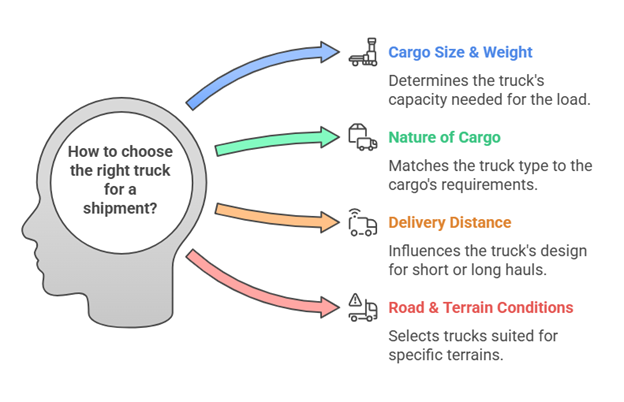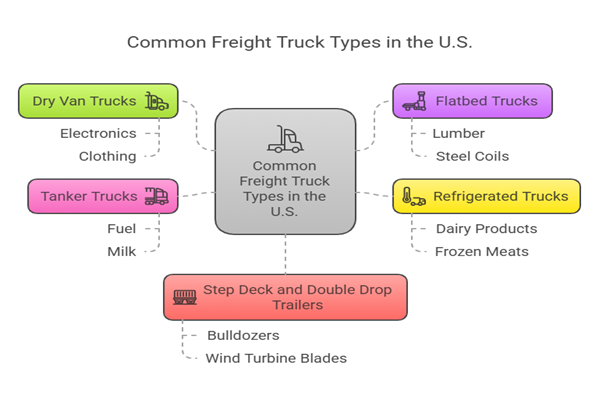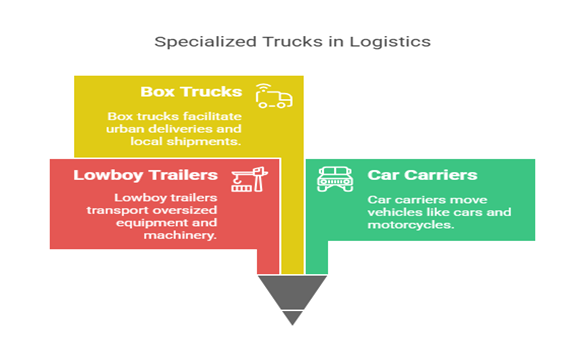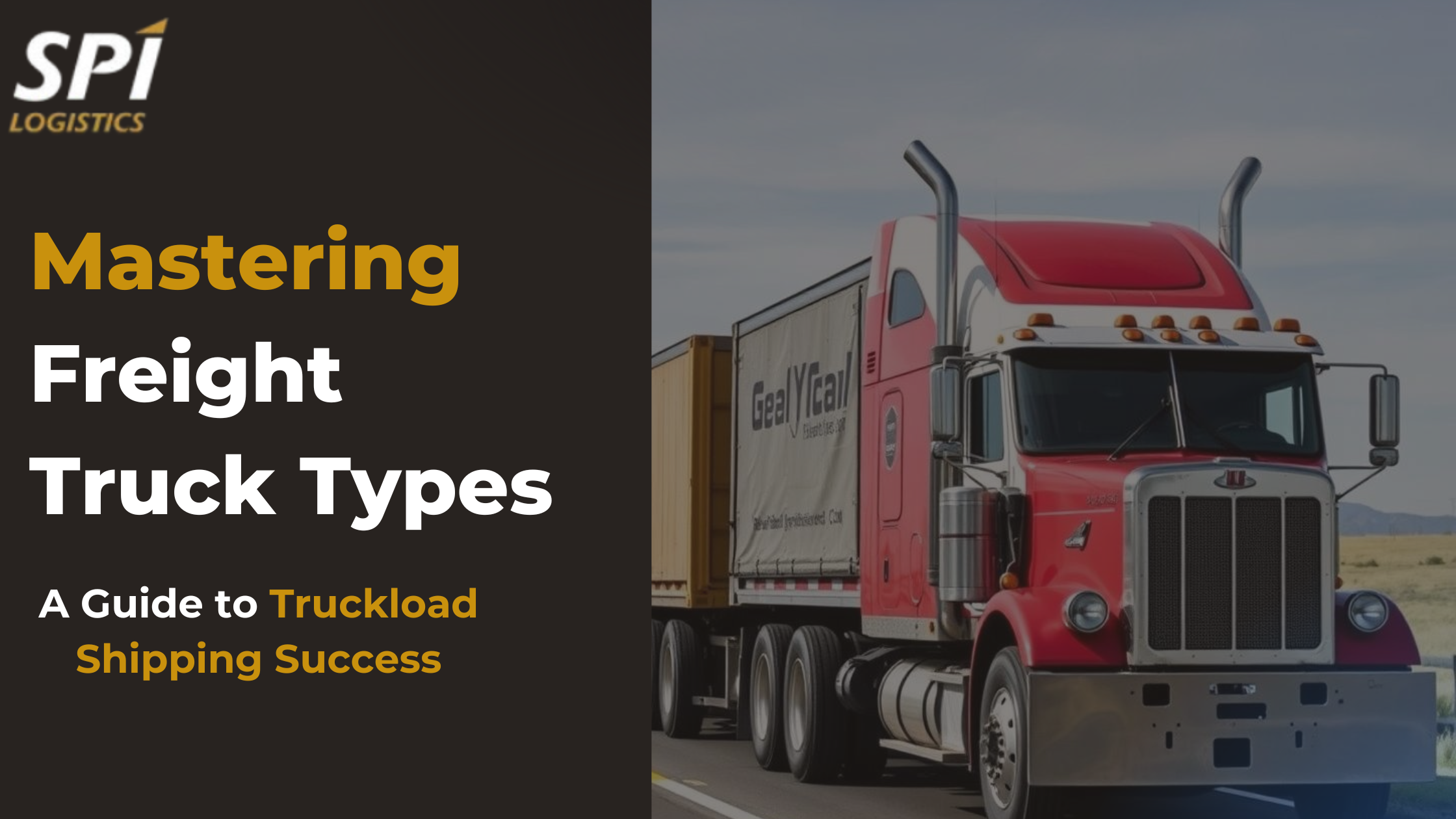Truckload shipping is one of the most reliable methods for moving large shipments nationwide. Whether coordinating deliveries or trying to choose the right truck for a job, knowing the different types of freight trucks can make all the difference in ensuring an efficient and cost-effective shipment.
What Is Truckload Shipping?
Truckload shipping is a method of freight transportation where a single shipment occupies the entire space of a trailer. Unlike Less Than Truckload (LTL) services that combine multiple loads, truckload shipping maximizes efficiency for larger shipments. It is commonly used for high-volume, high-weight freight, offering quicker transit times and reduced handling. This method is ideal for businesses needing to transport goods using specific types of hauling trucks tailored to the shipment.
From flatbeds to reefers, the logistics sector relies on different types of trucks for freight depending on cargo size, sensitivity, and delivery requirements. Understanding different types of truck loads is essential for choosing the right vehicle, especially when dealing with large motor vehicles used to carry freight. Whether it’s fragile goods or bulk items, matching truck and freight correctly ensures cost-effectiveness and delivery accuracy.
Truckload carriers moved nearly 11.5 billion tons of freight in 2023, accounting for more than 70% of all domestic shipments (American Trucking Associations, 2024). With high demand, knowing the truck that best suits your load isn’t just a preference, it’s a necessity.
“TL shipping remains the backbone of American logistics. For high-volume shippers, it’s the most efficient and damage-resistant option available.”
Key Factors for Choosing the Right Truck
Selecting the right truck for a specific shipment goes beyond simply choosing the available vehicle. It’s about understanding the nature of the freight and selecting from the different types of trucks that best suit the load. Several key factors must be considered when determining which types of freight trucks will provide the most effective and cost-efficient transport solution.
1. Cargo Size and Weight
The size and weight of the load are the primary determinants in choosing from the different types of truck loads. Larger and heavier cargo will require large trucks, while smaller loads may be best suited for medium-duty trucks. Heavy-duty trucks, such as freight truck types used in truckload shipping, are necessary for large shipments, while light-duty trucks can handle smaller, lighter shipments.
Examples:
- Light loads: Office furniture, smaller shipments.
- Heavy loads: Industrial machinery, large-scale manufacturing parts.
In a 2024 survey of logistics managers, 42% reported excess charges due to weight misclassification, highlighting the importance of accurate weight reporting (FreightWaves, 2024).
2. Nature of the Cargo
Different types of trucks for hauling are designed for specific kinds of cargo. For example, refrigerated trucks (reefers) are ideal for temperature-sensitive goods, while flatbed trucks are better suited for oversized or irregularly shaped items. Depending on whether the cargo requires temperature control, flat surfaces, or secure enclosures, selecting the right types of hauling trucks ensures that goods arrive in optimal condition.
Examples:
- Temperature-sensitive cargo: Pharmaceuticals, food items.
- Oversized cargo: Construction materials, machinery.
3. Delivery Distance
The distance the cargo needs to travel also plays a significant role in selecting the correct vehicle. Types of transport trucks like long-haul trucks (e.g., tractor trailers) are designed for intercity and interstate delivery, while smaller local delivery trucks are more suited for short-distance transport. Understanding whether the shipment is a full truckload (FTL) or less than truckload (LTL) will also impact which truck types are most appropriate for the job.
Examples:
- Long-distance deliveries: Nationwide freight shipments, bulk goods.
- Short-distance deliveries: Local grocery deliveries, last-mile shipments.
4. Road and Terrain Conditions
The terrain on which the truck will operate can influence the decision. Different types of trucks might be better suited for rough or rural roads, such as trucks equipped with all-terrain capabilities or lowboy trailers for heavy-duty equipment. Trucks operating in urban environments may need to be smaller, more maneuverable, and optimized for tighter spaces.
Examples:
- Urban settings: Small delivery trucks, box trucks.
- Rural or construction zones: Flatbed trucks, lowboy trailers.
One third-party logistics provider (3PL) shared a success story: After switching to higher-clearance flatbeds for remote construction deliveries, they reduced delivery rescheduling by 32% in Q4 2023 (FreightWaves, 2024).
5. Regulatory Requirements
In some cases, government regulations will affect the choice of truck. Certain truck types in USA may have weight restrictions or may require special permits, especially when transporting oversized or hazardous materials. Understanding these regulations ensures that the chosen freight truck types comply with local, state, and federal laws.
Examples:
- Oversized loads: Construction equipment, oversized machinery.
- Hazardous materials: Chemicals, fuel, explosives.
A recent Federal Motor Carrier Safety Administration (FMCSA) audit revealed that non-compliance with hazardous freight regulations led to $2.3 million in fines in 2023 alone (FMCSA, 2024).

“Understanding truck selection is a multi-factor equation that impacts your bottom line. Smart planning avoids delays, penalties, and damaged freight.”
What’s one unexpected factor you’ve considered when selecting a freight truck for a shipment?
Common Freight Truck Types in the U.S.
The truck types in USA logistics are as varied as the goods they carry. Let’s explore the most commonly used types of trucks in logistics and how they are categorized.
1. Dry Van Trucks
Dry vans are enclosed trailers that protect cargo from external elements. They’re among the most widely used types of delivery trucks for general freight.
Examples: Electronics, clothing, non-perishable food items, furniture.
Dry vans account for over 60% of all truckload shipments in North America (FreightWaves, 2024).
2. Flatbed Trucks
Flatbeds are perfect for oversized or oddly shaped loads. These are key types of transport trucks used in construction and manufacturing.
Examples: Lumber, steel coils, heavy equipment, concrete barriers.
3. Refrigerated Trucks (Reefers)
Reefers are temperature-controlled vehicles ideal for perishable goods. Among the different types of trucks for freight, these are essential for food and pharmaceutical transport.
Examples: Dairy products, frozen meats, fresh produce, vaccines.
The reefer market is projected to grow to $10.5 billion by 2027, driven by food and pharma (Statista, 2024).
4. Tanker Trucks
Used to haul liquids and gases, tanker trucks are specialized types of large trucks requiring specific handling.
Examples: Fuel, milk, chemicals, industrial oils.
96% of tank carriers passed 2023 DOT inspections with no safety violations (FMCSA, 2024).
5. Step Deck and Double Drop Trailers
These types of hauling trucks are designed for taller cargo that wouldn’t fit in standard flatbeds. They’re common in industries like mining and heavy machinery.
Examples: Bulldozers, excavators, wind turbine blades, oversized storage tanks.

“Selecting the right truck type isn’t just about fitting freight, it’s about operational efficiency and safety. Each type has a purpose built on decades of industry evolution.”
Which freight truck type do you rely on most frequently and why?
Types of Truck Loads
Freight is not one-size-fits-all. Understanding different types of truck loads helps optimize delivery strategies and truck selection.
-
Full Truckload (FTL): The entire trailer is used for a single shipment. This method is ideal for businesses shipping large quantities of the same item..
- Pros: Faster transit, less handling, lower risk of damage.
- Cons: More expensive if cargo doesn’t fill the truck.
Examples: Pallets of bottled beverages, bulk raw materials
-
Less Than Truckload (LTL): Multiple shipments share space in the same trailer. Best suited for small to medium-sized freight.
- Pros: Cost-effective for small shipments, flexible scheduling.
- Cons: More handling can increase the risk of damage or delay.
Examples: Mixed goods from multiple suppliers, small furniture.
-
Partial Truckload: A hybrid with shared space but fewer handling points than LTL.
- Pros: Lower cost than FTL, less handling than LTL.
- Cons: Limited availability, slightly longer delivery times.
Examples: Mid-sized machinery, large but not full trailer loads
-
Expedited Freight: Time-sensitive deliveries that often require dedicated freight trucks or team drivers.
- Pros: Fastest option, often includes real-time tracking.
- Cons: Most expensive option, requires precise coordination.
Examples: Medical equipment, urgent replacement parts.
Each category can be paired with specific types of freight trucks depending on the cargo and delivery needs.
“Understanding truckload types empowers businesses to align their logistics with customer expectations. It’s a major driver of satisfaction and retention.”
Looking for expert help selecting the best truck for your shipment? Explore our shipping services.
Specialized Truck Types
As freight diversity grows, so does the list of specialized vehicles. From hazardous materials to livestock, different types of freight demand dedicated kinds of trucks. Here’s a closer look at some of the most crucial truck types in USA logistics when it comes to special cargo
1. Lowboy Trailers: Used for transporting heavy equipment and machinery that’s too tall for standard flatbeds
Examples: Excavators, bulldozers, cranes.
2. Car Carriers: These large motor vehicles used to carry freight are designed specifically for moving automobiles. Vehicle logistics is forecasted to grow 4.2% annually due to EV demand (Statista, 2024).
Examples: Sedans, SUVs, motorcycles, fleet delivery.
3. Box Trucks: Smaller than dry vans, these types of delivery trucks are widely used in urban areas for local deliveries.
Examples: Household goods, retail inventory, parcel shipments.

Even among types of big trucks, functionality can vary greatly. Choosing between these options depends on cargo dimensions, weight, delivery urgency, and access points. The need to match specialized freight truck types to specific shipping scenarios is vital for efficiency and safety.
“Specialized trucks fill the niche needs of modern logistics. They’re purpose-built solutions in an increasingly complex supply chain.”
Have you encountered a shipment where only a specialized truck could get the job done?
Truck Classification by Weight
Understanding the different classifications of trucks is crucial for anyone involved in the logistics and transportation industry. These classifications are important when determining the types of freight trucks needed for specific loads and how they will operate within various transportation systems. Here’s an overview of how truck types are classified:
- Class 1-3 Trucks: These light-duty trucks include the smallest types of trucks typically used for local deliveries, service work, and light cargo. Often, these trucks are not used for freight truck types that carry large or heavy shipments. Their versatility makes them ideal for short-distance hauls and urban deliveries.
Examples: Pickup trucks, vans, and small delivery vehicles.
- Class 4-6 Trucks: These medium-duty trucks are a step up from light-duty vehicles. They are often used for types of transport trucks that carry goods in the medium weight range, such as construction materials, larger equipment, or large-scale deliveries. These trucks have more power and capacity, making them essential for businesses requiring a higher load capacity without the size of a heavy-duty truck.
Examples: Box trucks, delivery trucks, and smaller flatbed trucks.
- Class 7-8 Trucks: These heavy-duty trucks are the backbone of long-haul freight transport, used for the bulk of truckload shipping. These types of freight trucks include tractor-trailers, 18-wheelers, and different types of trucks in logistics that carry substantial freight loads over long distances. These trucks are designed for high-volume hauling, offering maximum space and capacity for the largest freight.
Examples: Semi-trucks, flatbed trailers, and tanker trucks.
This classification system helps shippers and logistics firms understand all types of trucks available based on their hauling capacity.
“Weight classes are more than numbers—they’re a regulatory and operational framework that determines what trucks can legally and safely do.”
Not sure which classification your fleet or shipment falls under? Explore our freight brokerage and back-office support for expert assistance.
Choose the Right Freight Truck for Every Load
The logistics landscape is built on savvy choices, from understanding types of truckloads to knowing which types of transport trucks fit your freight needs. Whether you’re handling temperature-sensitive pharmaceuticals or oversized industrial parts, there’s a match between your truck and freight—you need to know where to look. Choosing the right freight truck means balancing load type, truck capability, and route logistics. With dozens of different types of freight trucks to choose from, working with experienced freight brokers can help optimize every haul.
Ready to optimize your shipping? Connect with us to find the perfect freight truck for your needs.
References
American Trucking Associations. (2024). ATA Freight Statistics. Retrieved from https://www.trucking.org
FreightWaves. (2024). Freight Industry Trends and Reports. Retrieved from https://www.freightwaves.com
Federal Motor Carrier Safety Administration. (2024). HAZMAT Compliance Overview. Retrieved from https://www.fmcsa.dot.gov Statista. (2024). Reefer and Vehicle Logistics Market Forecast. Retrieved from https://www.statista.com




